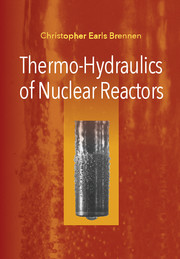5 - Core Heat Transfer
Published online by Cambridge University Press: 05 April 2016
Summary
Heat Production in a Nuclear Reactor
Introduction
In this chapter, the heat transfer processes within a normally operating reactor core are analyzed and hence the conditions in the core during the normal power-production process are established. It is best to begin with an individual fuel rod and gradually move outward toward an overview of the entire core. For more detailed analyses, the reader is referred to texts such as Gregg King (1964), Tong and Weisman (1970), Todres and Kazimi (1990), and Knief (1992).
Heat Source
As discussed earlier in Section 2.3.1, heat is produced within a nuclear reactor as a result of fission. The energy released is initially manifest primarily as the kinetic energy of fission products, of fission neutrons, and of gamma radiation. Additional energy is released as the fission products later decay, as discussed in Section 2.3.4. The kinetic energy is then converted to thermal energy as a result of the collisions of the fission products, fission neutrons, and gamma radiation with the rest of molecules in the reactor core. The majority of this energy (about 80 percent) is derived from the kinetic energy of the fission products. The fission neutrons and gamma radiation contribute about another 6 percent of the immediate heat production. This immediate energy deposition is called the prompt heat release to distinguish it from the subsequent, delayed heat release generated by the decay of the fission products. This decay heat is significant and contributes about 14 percent of the energy in an operating thermal reactor. As discussed earlier in Section 2.4.2, the fission product decay not only produces heat during normal reactor operation but that heat release continues for a time after reactor shutdown. Typically, after shutdown, the heat production decreases to 6.5 percent after 1 s, 3.3 percent after 1 min, 1.4 percent after 1 hr, 0.55 percent after 1 d, and 0.023 percent after 1 yr.
Most of this chapter focuses on how the heat deposited in the core is transferred out of the fuel and into the core during normal reactor operation. Because almost all of the heat deposited, whether prompt or delayed, is proportional to the neutron flux, it will be assumed in the rest of this chapter that the rate of heat production is directly proportional to that neutron flux.
- Type
- Chapter
- Information
- Thermo-Hydraulics of Nuclear Reactors , pp. 78 - 89Publisher: Cambridge University PressPrint publication year: 2016

